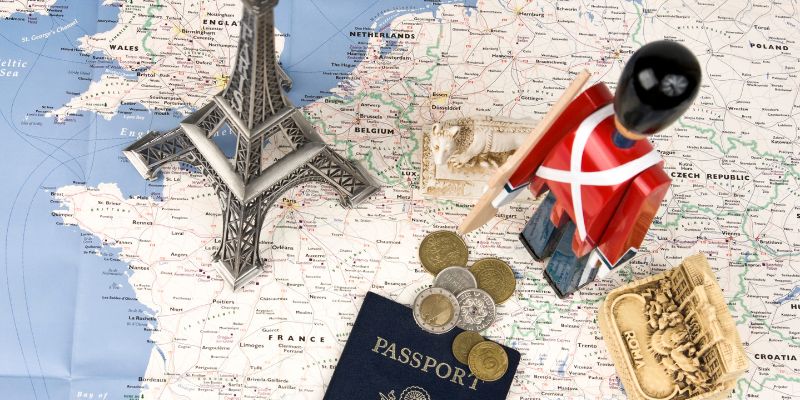If you are planning a trip to Europe in 2024, you may be wondering about the potential costs. Travel expenses can vary widely based on different factors such as destination choice, accommodation preferences, and mode of transportation. This post will provide an overview of estimated prices for traveling through Europe in 2024- from airfare to accommodations - while offering budget-friendly tips and tricks.

General Cost Factors
Many critical elements come into play concerning cost considerations when planning a European vacation. Firstly, seasonality plays an essential role: summer months might bring higher temperatures but inevitably increase both prices and crowds; instead, shoulder seasons (spring or autumn) could offer better discounts without compromising on quality experiences.
Secondly, the type of location selected could significantly affect one's finances, considering Eastern rather than Western countries. Finally, regarding individual taste, all luxury travelers who opt for high-end hotels & cuisine, compared to people who stick primarily with hostels & street food respectively.
Other variables that can have an impact are currency fluctuations within exchange rate trends accompanied by insights surrounding economic policies affecting overall traveling expenditure.
Ignoring travel insurance as an expense could lead to unexpected costs resulting from cancellations, medical emergencies, or lost items. For affordable connectivity, assess your mobile phone's roaming charges and international plans while traveling. Further dining and service expenses can increase due to different tipping customs in various countries.
Our ultimate goal remains to provide useful information and empower travelers looking forward to making their dreams come true financially feasible.
Regional Breakdown
The variation in the cost of travel across Europe is primarily influenced by its diverse regions. Comparatively, Western European nations such as France, Germany, and the UK are more expensive, while Eastern European countries like Poland, Hungary, and Romania offer lower prices. The living costs in Scandinavia are generally higher than those found in Southern Europe (e.g., Greece & Spain), which features moderately priced options for traveling. Facilitating better budgeting practices among travelers exploring these locations requires case studies or itinerary examples with estimated expenses to serve as a useful reference point before embarking on their travels accordingly.
Transportation Costs
Airfare
Airfare prices to travel to Europe seem like a strategic game, as they fluctuate based on several factors, such as season, time of booking, and airline preference. It is generally advisable to book well in advance for lower rates and be flexible with the dates you intend to travel so that surprising deals are spotted easily. Keep an eye out for budget-friendly airlines offering competitive pricing, but ensure knowledge of any additional fees chargeable for baggage or other services they offer. Besides this, it pays off using flight comparison tools; they help identify the best times and routes when making bookings.
Within Europe
Within Europe, transportation infrastructure also offers different options suiting various preferences. For instance, trains offer scenic comfort traveling with extensive networks, mainly in Western and Central European countries. If extended travels are currently planned, rail passes known as Eurails might be handy. A cheaper alternative would be buses, which cover extensive regions across the continent. Low-cost regional flights between cities must be addressed, too, but keen consideration should always compare costs and scheduling. FYI: It plays a part in determining itinerary choices.
Accommodation Costs
Europe has a diverse selection of accommodations to match all budgets, from luxurious hotels to cozy hostels. Rates depend largely on location, with central areas commanding steeper prices. While opting for convenience and comfort will set you back more at hotels, budget-friendly options like dorms or private rooms are available at hostels. Vacation homes listed on Airbnb offer unique local experiences and greater space and amenities; pre-booking can yield better rates, and staying outside major tourist destinations cuts down expenses considerably. Additionally, it's highly recommended that visitors read reviews thoroughly before booking lodging and check if extra charges are levied apart from base fees wherever applicable.
Daily Expenses
Food and Dining
Dining out in Europe offers diverse experiences, from deluxe fine dining to fast and economical carts. Prices tend to differ according to the country and city, with Northern and Western regions typically being more expensive. Eating at local markets is an excellent choice if you're looking for cheaper options while still enjoying delicious cuisine since they offer fresh yet affordable meals. Another option would be trying fixed-price lunch menus provided by several restaurants that generally cost less without compromising quality or satisfaction rates. Furthermore, purchasing groceries from regional supermarkets can also aid in maintaining your budget during your trip if opting for self-catering facilities rather than frequent restaurant visits.
Attractions and Activities
Europe is filled with captivating sights, from prestigious museums to ancient landmarks. Several prominent destinations require entry tickets, which can quickly accumulate expenses. Consider procuring city tourism cards with price reductions or free visits to numerous venues to conserve costs. Moreover, some exhibition halls have complimentary admissions on certain days or reduced charges granted for pupils and the elderly group. Exploring via walking tours founded upon gratuities presents reasonably priced but enriching options.
Money-Saving Tips and Tricks
You can extend your budget to cover more ground by applying some clever travel tricks.
- Opting for discount cards for students, youth, or seniors lets you save enough on transportation, lodging, and sightseeing expenses.
- Travel during off-season periods means lower rates and less of the usual tourist crowd. If traveling solo, opt for dorms in hostels as they are economical - great deal!
- Getting around with local public transport instead of cabs reduces costs, and indulging at marketplaces or street stalls is a good idea, too, if aiming to limit spending while exploring taste sensations locally.
- Carrying refillable water bottles will drastically reduce your daily budget –try finding free refill points wherever possible.

Conclusion:
In the conclusion, we recap the journey through the various aspects of budgeting for a European trip in 2024. Key points like understanding airfares, accommodations, daily expenses, and the cost differences between regions were highlighted. The importance of planning and budgeting for the trip was emphasized, alongside tips for saving money.

Decoding the Blue and Red Colors on Japanese Vending Machines: A Guide for Tourists

Travel Guideline to Colombo Fort with the Best Recommendations and Tips

Best Resorts of Saputara for a perfect getaway

Mahathobara Shri Mangaladevi Temple

Finding Happiness Around the Globe: Our Top 5 Joyful Destinations

Luxury at FabHotel Star Suites, Goregaon West, Mumbai

Best Things to Do in Noida 2023: Activities and More

Manas National Park Elephant Safari

Bangalore Shopping Havens: Top Spots

Things to Do in Jodhpur, Rajasthan Adventurous Trip

Weekend Getaway At ALuxurious Vineyard 2023
